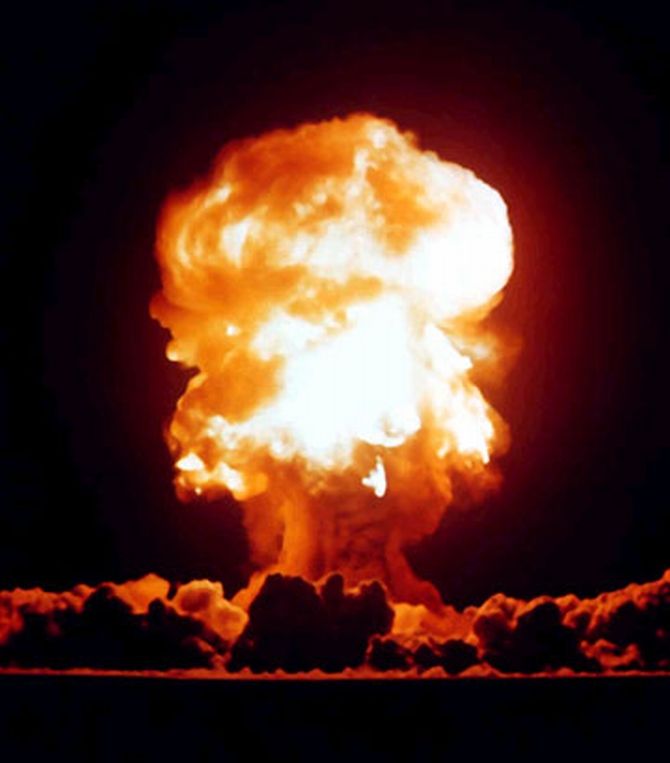 | « Back to article | Print this article |
Researchers at the Global Challenges Foundation in Stockholm have released a thorough scientific assessment of what threatens human civilisation, or even possibly, all human life.
The assessment is quite thorough and unsettling.
According to the researchers, “This is a report about two extremes, not one. It is about how a better understanding of the magnitude of the challenges can help the world to address the risks it faces, and can help to create a path towards more sustainable development.”
“It is a scientific assessment about the possibility of oblivion, certainly, but more than that it is a call for action based on the assumption that humanity is able to rise to challenges and turn them into opportunities,” it says.
Let’s take a look at the doomsday scenarios:
Artificial intelligence

The field is often defined as ‘the study and design of intelligent agents’, systems that perceive their environment and act to maximise their chances of success.
Such extreme intelligences could not easily be controlled (either by the groups creating them, or by some international regulatory regime), and would probably act to boost their own intelligence and acquire maximal resources for almost all initial AI motivations.
And if these motivations do not detail the survival and value of humanity, the intelligence will be driven to construct a world without humans.
The best current estimate of an uncertain risk in the next 100 years is:
5 per cent for infinite threshold;
0.1% for infinite impact
Extreme climate change

According to the report: The impact of global warming would be strongest in poorer countries, which could become completely uninhabitable for the highest range of warming.
Combined with shocks to the agriculture and biosphere-dependent industries of the more developed countries, this could lead to global conflict and possibly civilisation collapse. Further evidence of the risk comes from signs that past civilisation collapses have been driven by climate change.
The best current estimate for extreme climate change in the next 200 years is:
5 per cent for infinite threshold;
0.01 per cent for infinite impact
Nuclear war

The likelihood of a full-scale nuclear war between the United States and Russia has probably decreased. Still, the potential for deliberate or accidental nuclear conflict has not been removed, with some estimates putting the risk in the next century or so at around 10 per cent.
A larger impact would depend on whether or not the war triggered what is often called a
nuclear winter or something similar -- the creation of a pall of smoke high in the stratosphere that would plunge temperatures below freezing around the globe and possibly also destroy most of the ozone layer.
The best current estimate for nuclear war in the next 100 years is:
5 per cent for infinite threshold;
0.005 per cent for infinite impact
Global pandemic

All the features of an extremely devastating disease already exist in nature -- essentially incurable (Ebola), nearly always fatal (rabies), extremely infectious (common cold), and long incubation periods (HIV).
If a pathogen were to emerge that somehow combined these features (and infuenza has demonstrated antigenic shift, the ability to combine features from diferent viruses), its death toll would be extreme.
Modern transport and dense human population allow infections to spread much more rapidly, and slums can be breeding grounds for disease.
The best current estimate of a global pandemic in the next 100 years is:
5 per cent for infinite threshold;
0.0001 per cent for infinite impact
Ecological collapse

Humans are part of the global ecosystem and so fundamentally depend on it. Species extinction is now far faster than the historic rate, and attempts to quantify a safe ecological operating space place humanity well outside it.
Many of the problems of ecological degradation interact to multiply the damage and the whole world is potentially at risk.
The best current estimate of an ecological catastrophe in the next 100 years is:
0.5 per cent for infinite threshold;
Global system collapse

The world economic and political system is made up of many actors with many objectives and many links between them. Such intricate, interconnected systems are subject to unexpected system-wide failures caused by the structure of the network -- even if each component of the network is reliable.
This gives rise to systemic risk, when parts that individually may function well become vulnerable when connected as a system to a self-reinforcing joint risk that can spread from part to part, potentially affecting the entire system and possibly spilling over to related outside systems.
Major asteroid impact

Large asteroid collisions -- with objects 5 km or more in size -- happen about once every 20 million years and would have an energy a hundred thousand times greater than the largest bomb ever detonated.
A land impact would destroy an area the size of a nation such as Holland. Larger asteroids could be extinction-level events.
The best current estimate of a major asteroid impact in the next 100 years is:
0.01 per cent for infinite threshold;
0.00013 per cent for infinite impact
Super volcano

The danger from super-volcanoes is the amount of aerosols and dust projected into the upper atmosphere. This dust would absorb the Sun’s rays and cause a global volcanic winter. The Mt Pinatubo eruption of 1991 caused an average global cooling of surface temperatures by 0.5°C over three years, while the Toba eruption around 70,000 years ago is thought by some to have cooled global temperatures for over two centuries.
The effect of these eruptions could be best compared with that of a nuclear war.
The best current estimate of a supervolcano in the next 100 years is:
0.002 per cent for infinite threshold;
0.00003 per cent for infinite impact
Synthetic biology

One of the most damaging impacts from synthetic biology would come from an engineered pathogen targeting humans or a crucial component of the ecosystem.
This could emerge through military or commercial bio-warfare, bioterrorism
(possibly using dual-use products developed by legitimate researchers, and currently nunprotected by international legal regimes), or dangerous pathogens leaked from a lab.
The best current estimate of an impact from synthetic biology in the next 100 years is:
1 per cent for infinite threshold;
0.01 per cent for infinite impact
Nanotechnology

Atomically precise manufacturing, the creation of effective, high throughput manufacturing processes that operate at the atomic or molecular level. It could create new products -- such as smart or extremely resilient materials – and would allow many different groups or even individuals to manufacture a wide range of things.
Some have conjectured special self-replicating nanomachines which would be engineered to consume the entire environment. The misuse of medical nanotechnology is another risk scenario.
The best current estimate of an impact from nanotechnology in the next 100 years is:
0.8 per cent for infinite threshold;
0.01 per cent for infinite impact
Unknown consequences
These represent the unknown unknowns in the family of global catastrophic challenges. They constitute an amalgamation of all the risks that can appear extremely unlikely in isolation, but can combine to represent a not insignificant proportion of the risk exposure.
“One resolution to the Fermi paradox -- the apparent absence of alien life in the galaxy -- is that intelligent life destroys itself before beginning to expand into the galaxy,” it says.
The best current estimate of an uncertain risk in the next 100 years is:
5 per cent for infinite threshold;
0.1 per cent for infinite impact
Future bad global governance

There are two main divisions in governance disasters: failing to solve major solvable problems, and actively causing worse outcomes.
An example of the first would be failing to alleviate absolute poverty; of the second, constructing a global totalitarian state. Technology, political and social change may enable the construction of new forms of governance, which may be either much better or much worse.